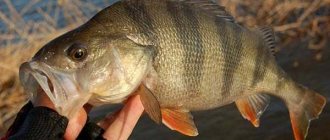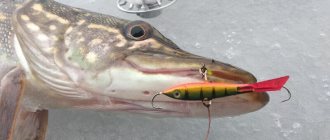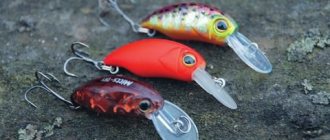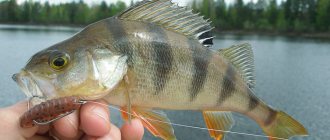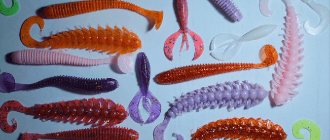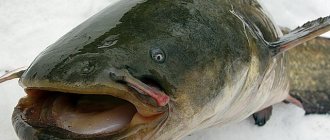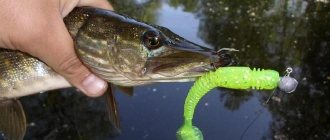Perch fishing is one of the most popular types of fishing among our anglers. Perch can be caught all year round: both in winter and in summer. In the summer, perch is caught using a float rod, bottom tackle, spinning rod, girders and mugs. In winter, perch is caught using spoons, balance beams and jigs. Perch fishing is one of the most dynamic types of fishing; the angler has to move around the reservoir in search of an active perch, select bait and fishing tactics that can provoke a predator to bite.
In our publication, we will understand the tricks of perch fishing, talk about fishing places, the behavior of perch at different times of the year, consider the main artificial and natural baits, and understand all the ways in which anglers catch this fish.
Appearance and lifestyle of perch
Perch is one of the most common fish in our country. Perch can be found everywhere: in rivers, lakes, ponds and reservoirs. Thanks to its memorable appearance: pronounced striped color and yellow-orange fins, perch is difficult to confuse with other fish. The perch has a laterally compressed body covered with dense small scales. The height of the perch's body is one third of its length, so the perch looks like a massive fish.
In large reservoirs with a rich food supply, perch forms two varieties that differ in habitat, diet and growth rate. The first variety is usually called "small", "grass" or "coastal" perch, the second - "large" or "deep" perch.
In reservoirs, perch adheres to the coastal zone of the reservoir, overgrown with aquatic vegetation, as well as areas of reservoirs with artificial and natural shelters.
The perch spends most of its life near the bottom. In large bodies of water, at great depths, schools of small perch are located at depth drops, that is, places where there is a sharp increase in depth. Schools of perch go to shallow waters to hunt for fry, which stay in large numbers in such places.
A perch boil occurs when a school of perch surrounds a fry, forcing the fry to rise to the very surface or even jump out of the water in an attempt to escape from greedy predators. The water in such places is said to boil. A large number of fry jumping out of the water attracts seagulls and other fish-eating fish. It is by flocks of birds circling in one place that fishermen find perch pots.
In the warm season, perches stay in creeks and bays overgrown with aquatic vegetation, while medium-sized perches keep in schools of up to 10 fish, and small-sized perches can have a school size of up to 100 fish.
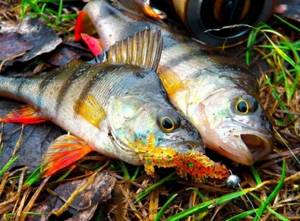
Spawning of perch occurs immediately after ice drift, at a water temperature of 7-8 °C. In the southern regions of the country this occurs in February-April, in more northern regions in May-June. Perch spawning usually occurs immediately after pike spawning. Large perches begin spawning later than small ones.
During spawning, the female lays mesh ribbons of gelatinous substance, on each edge of which there are 2-3 eggs, on last year’s vegetation, flooded bushes and snags, or even just on the bottom, and the males fertilize them. The diameter of the perch egg is about 4 mm, the length of the ribbon can be from 12 cm for small perches, up to 1 meter long for large ones.
A little theory
Before moving on to practical advice “Where?”, “When?” and “How to catch perch?” I suggest you familiarize yourself with the theory a little. Many spears and fishing rods have been broken in scientific discussions about whether to divide the species of river perch (Perca fluviatilis., lat.) into separate subspecies: “deep” - large, predatory and “coastal” - small, omnivorous. Official science has adopted the following postulate: “river perch forms two different ecological forms, or races, which differ in habitat, diet and growth rate.” Moreover, at the first stages of development, these forms live and feed together in the coastal zone, and then are divided according to the type of nutrition and localization in the reservoir, which introduces additional confusion into the taxonomy.
The coastal form prefers to stay in flocks in small creeks with a slow current, near bridge supports, piles, flooded bushes and snags. Small dumps, aquatic vegetation and stones provide them with shelter from predators and hunting grounds. The diet consists of insect larvae, zooplankton, fry, and worms.
Large perch (in the slang of site visitors, “humpbacked” or “sea”, as opposed to coastal - “sports”) lives at considerable depth, in whirlpools and channel holes, which it leaves only for hunting. It usually gathers in small flocks only during the feast. It feeds mainly on small fish, shellfish, etc. However, this division is very arbitrary. For example, I had to catch respectable specimens weighing up to 1.5 kg from the shore with a fishing rod using a worm, and on a spoon, at a depth of 6-8 m, it happened that specimens hardly larger than the bait itself landed.
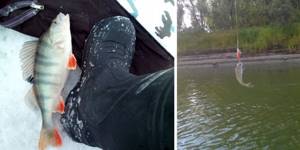
The behavior of this fish largely depends on the time of year. In the spring, after spawning, perch migrates to the mouths of rivers and streams and can rise upstream in search of food. Doesn't bite well in muddy water. As the water level drops, it rolls down to its main habitat. In summer and autumn, it actively feeds both in deep and shallow water, gathering in huge flocks. Finding such a “boiler” is a great success for a fisherman. Driven by instinct, the perch greedily pounces on any offered bait, trying to get ahead of its fellow tribesmen. This continues until freeze-up.
During the first ice, perch is usually better caught with a spoon and a balance beam; in the dead of winter it can be almost passive, but there are times when the fish bite on insect larvae, zooplankton or baits that imitate them. Ichthyologists explain this by the fact that caviar or milt, at this time, occupy most of the abdominal cavity of the fish, and it is physically unable to swallow large objects.
Read about catching winter perch using a balance beam in our article. It reveals fishing techniques, tactics, which balancers are best to fish with and much more.
Where to catch perch
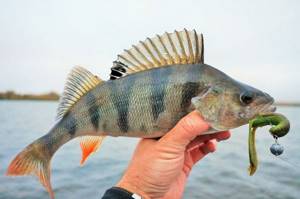
- Deep holes and pools Trophy-sized perch often stay in such places. The perch can stand both in the hole itself and at the exit from it. Perch often stays on the edge of currents, but avoids the main stream. Pits and pools are the main place for catching perch in winter, during the deep winter.
- Steep slopes of the depths, channel and bank edges are favorite sites for perch schools. Perch fishing in such places is sometimes done from the shore, but more often from a boat.
- Underwater elevations, especially in large bodies of water, there must be a large column of water above the elevation.
- The sandbank, with a sharp drop to depth, is an excellent place for catching perch.
- Reeds and underwater vegetation, perch often stands in thickets, as if in ambush, waiting for fry.
- Bridge supports, hydraulic structures, and piers are good places for bass to rest, as well as an excellent place to ambush small fish.
- Flooded logs, bushes, and snags are favorite places for perch camps.
Summer vertical perch fishing
You can catch perch in the summer from a boat in a vertical position. To successfully catch perch vertically, you should select rods up to one meter in length with a very soft and sensitive rod tip. If there is no such fishing rod, then you can install a nod on the tip of the rod , intended for installation; on winter fishing rods, with its help you will be able to notice even the most insignificant change in the behavior of the bait.
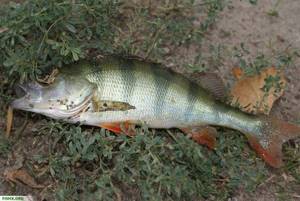
Share with your friends!
Spring
In the spring, at the end of March - beginning of April, when the ice has moved several meters away from the shore, the water is still too cold and the perch is not very active at this time. The perch stays far from the shore at this time. You can catch it on a spinning rod, using silicone baits and the slowest retrieval. It is best to fish in cloudy weather, in the middle of the day.
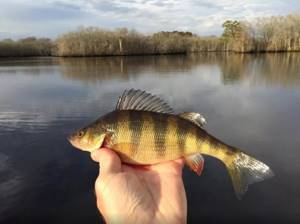
As the water warms up, the perch moves to shallow waters, not far from the shore, and begins to actively feed on small fish, preparing for spawning. Perch fishing at this time is carried out both with a spinning rod and a float rod. At this time, perch can be caught at shallow depths, close to the shore. At this time, you can catch a trophy specimen. With the start of spawning, perch fishing stops.

As soon as the spawning period ends, the perch begins to actively feed in order to regain strength after spawning, and is caught unevenly, in bursts, throughout the day. At this time, the perch stays in shallow waters, not far from the shore, in the warmest water. Fishing can be done using a spinning rod, spinners and wobblers, or a float rod. A boat is not needed at this time, since the perch is located close to the shore and fishing from the shore is more convenient for the angler.
In May, with further warming of the water, perch becomes less active, leaves shallow places and disperses to new points throughout the reservoir, while continuing to be caught.
Summer
In early June, perch gather in small schools that move around the reservoir in search of food. The main food of perch in summer is a variety of small fish. When hunting, schools of perch come close to the shore. A school of perch chases the fry, surrounds it and begins to eat. The perch fight is evidenced by circles on the water and fry jumping out of the water. For catching perch during a fight, spinning fishing with a spoon or wobbler is best suited. It fishes best in places where whitebait accumulates in large quantities.
You may be interested in: PVC boats
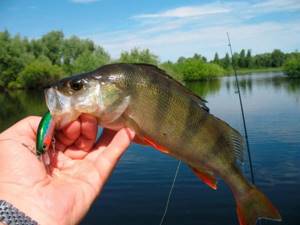
With the onset of heat and an increase in water temperature in July, the perch moves to depths where the water is cooler. At this time, the perch is most active in the morning at dawn and in the evening at sunset. During hot weather, perch takes refuge in the shade. Schools of perch can begin to attack fry as early as the afternoon. Spinning fishing is the most effective.
In August, perch is especially active and voracious; this is the best time to catch it. At this time, perch fishing is effective both with spinning and float tackle. With a spinning rod, perch is caught using a spinner or a wobbler, and when the perch stays at depth, drop-shot fishing gives good results. When catching perch with a float rod, live bait is considered the best bait. Fishing for perch with live bait is carried out in reservoirs with standing water or in reservoirs with a slow current. On hot days, fishing is carried out in the morning and evening; on cloudy days, perch fishing can be carried out all day.
Find big bass habitats
First of all, you need to find out where large perch most often stay. This search, of course, may take a lot of time, but believe me, everything will pay off with good catches. In each body of water there are certain depths that are occupied by medium and small fish, and such depths that larger fish adhere to. For the Dnieper in the Kyiv region, in the Kanevsky and Kievsky reservoirs, the depth of stay of large perches is approximately 3-5 meters. To catch larger perches, you first need to give up fishing in shallow waters, where small perch predominate, and fish in greater depths. It is important to find and remember places that stand out against the background of a monotonous underwater landscape.
In any body of water, large perch occupy the most favorable places for hunting. It is in such places that large perch can be found. An underwater anomaly that attracts large perch can be elevations or a small hole, flooded trees, rock ridges or a simple snag at the bottom of the reservoir. It turns out that large perch can be found very regularly in the area of difference in depth. A separate island of algae in such a place can make this place even more attractive for large perch.
Small fish gather near a tree that has fallen into the water or a stump rising above the water, followed by a predator. If, when fishing for perch, you notice that in some place there are larger perches, it means that somewhere nearby there is something underwater anomaly that attracts them, and this is exactly what we are looking for. Large perch usually set up camps in the same places year after year, and they are extremely rarely empty. Therefore, if you manage to catch one large perch, then after a certain period of time another large perch will take its place. When you find yourself in the fishing zone for the first time, it is advisable to explore it with an echo sounder and mark places with depth changes or underwater obstacles. You shouldn’t immediately drop anchor and start fishing the place. It’s better to walk through the area with an echo sounder several times up and down to get an accurate idea of the bottom topography in the fishing area. Catching large perch
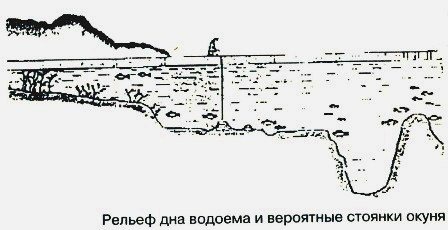
Autumn
September is the best time to catch perch in the fall. In early autumn, perch stay in schools that move along the coastline in search of schools of small fish. Perch is a schooling fish, and the larger the perch, the fewer heads the school has. The perch bite in September is active and lasts throughout the day. You can catch perch at this time using a float rod and spinning rod.
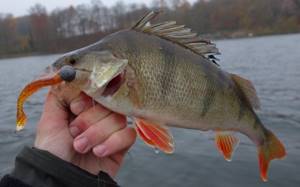
The best bait when catching perch on a float rod is live bait. Roach or crucian carp are well suited for the role of live bait.
When catching perch in the fall with a spinning rod, you can fish both from the shore and from a boat. You can fish with rotating and oscillating spoons, wobblers and silicone baits. You can fish all day, the perch is preparing for winter, is constantly hungry and takes bait all day.
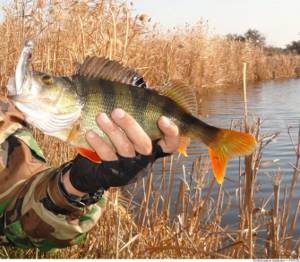
In October, the ambient temperature drops, the water becomes colder, and the perches sink closer to the bottom. The perch becomes more passive. This is especially noticeable on cloudy days, with changes in weather. It is best to look for perch at this time in depth. Good results are shown by fishing with a spinning rod on a retractable leash.
In November, perch becomes even more capricious and less active due to constant changes in weather conditions and low water temperatures. At this time, it stays near the bottom and does not completely stop coming to the surface. You can catch perch at this time using a spinning rod on a retractable leash, casting hooks, or live bait.
Lures
All types of lures for catching large perch should not be small in size. The size of baits should be either medium or relatively large. Of course, you should not use giant-sized spoons, as when catching large pikes. But there is no need to install very small turntables or twisters. Small fish will peck at them and thereby distract you from catching perch of the desired size.
The spinner has always been considered a perch spoon. Such baits always work well for perch. And in a big way, too. You just need to choose larger baits. Otherwise, there is a chance of catching small fish instead of humpback whales.
Twisters and vibrotails are also good for catching large perch. Lure sizes are medium or large. A large perch will undoubtedly attack even a fairly large artificial fish, even when it seems that it will not fit into its mouth. In cluttered places, offset hooks work well, making these baits a kind of “unhooked hook”.
Wobblers always catch fish well and large perch too. It is preferable to use a medium wobbler size, 5-6 cm long. And you definitely need to select the depth if you plan to fish at depth. Topwater poppers work well when big bass come out to feed in the shallows and hunt small fish close to the surface of the water.
In thickets of grass and reeds, an ordinary medium-sized oscillating spoon in the “non-snag” design works very well. It is especially good at fishing in thick reeds, where most other baits cannot be properly passed through the grass thickets.
Natural fish attached to a tackle has always been and remains a good bait, often replacing all spinners. In addition to large perch, pike often take this bait.
Also in deep places it is practiced to catch perch using tackle with a retractable leash. A fairly heavy sinker is attached to the lead and slides along the bottom, while the main lead with the bait goes behind at a short distance from the bottom. The bait in this case is usually a small wobbler.
You can catch large perch with a balance beam and a vertical spoon all year round. Of course, it is preferable to fish from a boat and in deep places. In shallow waters, normal fishing with such gear will not work. It is especially good when the boat is carried by a slight breeze, and the fisherman has the opportunity to move in the boat across the pond, fishing all the necessary territory, without making any effort to row or touching the oars.
Read: Catching perch with live bait
Winter
The two best periods for catching perch in winter are the first and last ice. During the deep winter period, the best time for fishing will be the thaw periods, when if the angler manages to find a perch site, he will be able to return home with a decent catch.
During the period of first ice, fishermen make the largest catches. Perch fishing is carried out using spoons, balancers and jigs with bloodworms. In early and mid-December, perch are very active and aggressively attack bait. It is best to look for perch at this time in holes, pools, near snags, under steep banks.
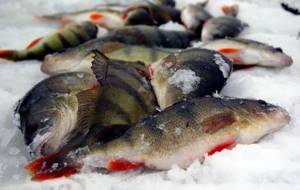
Closer to the middle of winter, in January, the period of deep winter begins. The perch becomes more passive, its bite worsens. At this time, perch prefers to stay closer to the bottom, in holes where the water temperature is higher and there is more oxygen. In the dead of winter, it is best to catch perch using a jig or a vertical spoon. In order to find perch, you have to make holes both close to the shore and above uneven bottoms and over holes. If there are no bites in the hole, you should move to the next one. The best time for fishing is either calm frosty weather or a thaw.
As spring approaches, at the end of February, meltwater falls under the ice, the water begins to be enriched with oxygen, and the perch becomes more active. Schools of perch move closer to the shore, staying near the mouth of tributaries flowing into reservoirs. At this time, perch is caught using spoons and jigs. Spoons with a freely hanging hook give good results. Fishing with jigs is done with natural baits, which include bloodworms, worms, and pieces of fish. The hole can be fed; bloodworms are used for this.
What to catch perch with
Perch can be caught using a wide variety of baits. All lures for catching perch are divided into two large groups: artificial and natural.
Artificial baits for catching perch
Artificial baits are widely used in bass fishing. Rotating spoons, silicone baits and wobblers are used when fishing with spinning rods. Winter vertical spinners, balancers and rattlins are used for winter ice fishing.
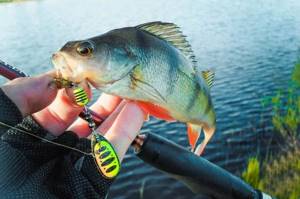
Spinner
one of the main lures for catching perch with a spinning rod. It consists of a wire rod on which a metal petal and a treble hook are attached. When the spoon moves in the water, the petal rotates around the rod, creating high-frequency vibrations in the water that attract perch. Spinner baits are easy to use and catchy. For perch fishing, spinners with blade sizes No. 1 and No. 2 are used.
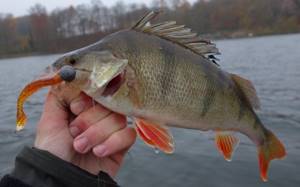
Silicone baits
Excellent for catching perch. The usual size of a silicone bait for catching perch is 4-5 cm; larger perches can be caught using larger baits.
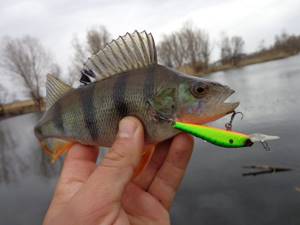
Wobbler
is a voluminous bait made of wood or plastic that is used for fishing with spinning or trolling.

Winter spinners
perch are used to catch it from the ice in winter. They are divided into vertical spinners and planning spinners. Spinners for sheer trolling are most often used for catching sluggish passive perch, mainly in the middle of nowhere. Anglers often call them studs or verticals. Such spoons deviate slightly from the hole during fishing. Gliding spoons are used in shallow waters when catching active perch. This category is best suited for shallow waters where you have attacked a school of active bass. They have a lively game and deviate strongly from the hole, attracting active perch. The length of the spoon for perch is 3-5 cm. For catching small perches, spoons with a length of 1.5-2 cm are well suited. For catching trophy perch, spoons with a length of 5 cm and above are used.
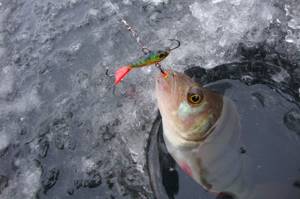
Balance
The bait used for catching perch from ice in winter imitates a small fish. The balancer has a plastic or metal tail, thanks to which the balancer moves under the hole in the form of a figure eight or a pendulum. The balancer is equipped with two single hooks, one of which is located on the head, and the second in the tail of the balancer and a hanging tee. The weight and size of the balancer for perch fishing is selected depending on the fishing conditions. Most often, a balancer for catching perch has a length of 3 to 6 cm and a weight of 4 to 10 grams.
You may be interested in: DaMiKi Pirami 55S. Scout hero.

Rattlin is a special type of wobbler that can be used for perch fishing both in summer and
to and in winter. Rattlin should be fished in places where the bottom is clear and it is impossible to catch on snags or other underwater obstacles. To catch perch, use silent rattlins 4-5 cm long. When fishing in winter, rattlins are fed vertically; when the rattlin is lowered, it creates small vibrations and sways slightly, which attracts the attention of the perch. In order to force the rattlin to play, the angler jerks the rod 30-50 cm.
Natural baits for catching perch
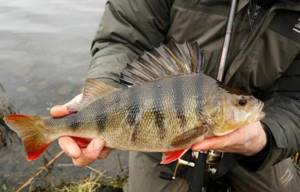
The best natural baits used for catching bass are:
- Live bait (preferably with a narrow body)
- Bloodworm
- Earthworms, earthworms or dungworms
- Maggot
- Chicken giblets
- Fish pieces
Perch. Characteristic features and habitat of fish.
Perch is one of the most common fish living in fresh water bodies of Russia. Found in rivers, lakes and ponds with fresh water. It is a predatory fish that feeds mainly on small animals and fish. However, bass preferences may change. This individual does not refuse worms, bloodworms, leeches and other insects. Due to these features, you can catch perch in different ways using almost any bait and tackle. That is why fishermen love him so much.
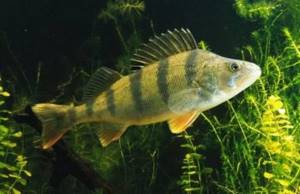
This predator is unpretentious in its choice of food; it uses worms, leeches, mollusks and fry of other fish.
A portrait of a perch can be drawn up without much difficulty, since this fish is known to almost everyone. The standard “minke whale” (the fish is called this way for its specific coloring) has a large, wide body with a slight curve on the back, yellow-green sides, a yellow belly and long black stripes across the body. The fins are multi-colored: red on the belly, gray on the back, yellow on the chest. The eyes are bulging, orange, the teeth are small and sharp. The color of a perch is largely influenced by its habitat, the color of the water and bottom soil. Often there are specimens darker or lighter than standard individuals. As a rule, small perches are yellow-green, weigh no more than 200 g, sometimes specimens weighing 30-25 g are found, while large individuals gain weight up to 700 g. Small fish are usually found in shallow coastal waters, and large fish prefer the open part of the reservoir .
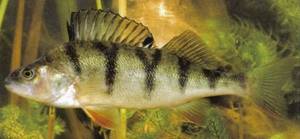
Small perch are herbivores, feeding on plant foods.
The lifespan of this fish is about 15 years. It has been noted that females live longer than males, sometimes living up to 24 years. Sexual maturity of perch begins at the age of 4-6 years. Spawning begins immediately upon opening the reservoir, when the water temperature reaches 10-13°C. In the southern regions it begins in March. Lasts until April. In the northern regions, spawning lasts from May to June. Spawning can take place in completely different places, both at a depth of 20-30 cm and at a depth of several meters; the choice of places for spawning perch is quite large. These can be thickets of plants, sandy and rocky soils. Individuals that have grown to 4-5 cm begin to hunt for larvae and worms, this once again confirms that perch is an omnivorous fish.
They also feed on their smaller relatives. Predators such as pike perch, pike, eel, and catfish are considered competitors of perch in the underwater world.
The diet of the “minke whale” is not monotonous. For example, in reservoirs rich in fish, from an early age it begins to feed on fry. Perches living in lakes and rafting rivers do not disdain the larvae of beetles and other insects. Crayfish, frogs, leeches, and snails can also serve as food for this fish.
Perch is a schooling fish. Fish of approximately the same age and size gather in schools.
As you know, perch is a fish that lives and hunts in a school, which can consist of several or more than a hundred individuals. The size of the school depends on the number of fish inhabiting a particular body of water, as well as on the availability of food and the time of year. The flock gathers specimens of approximately the same size and age. Large fish live separately.
In summer, perch is found in different places in the reservoir. Small fish choose coastal thickets, islands and channels. Large perch prefers fast underwater currents, coastal dumps, and the mouths of rivers and streams. Perch is found in reservoirs and dams where small fish gather. From time to time he moves to another place, following the fry, which serve as food for him. The whirlpool is a favorite habitat for river perch.
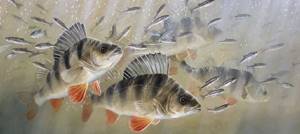
The location of a perch in a pond can be determined by the circles in the water left by the fry escaping from pursuit.
It is easier to determine the location of the “predator” in the early morning in calm weather. To do this, you should carefully monitor the water. While hunting for fry, the perch appears on the surface of the reservoir, swallows air and makes slurping sounds. The location of the perch can also be determined by the fry swimming away from the predator and at the same time jumping out of the water.
While hunting for small fish, a perch can get carried away and jump ashore.
In autumn, the lifestyle of the “striped predator” changes. Since the upper layers of water become colder in September-October, the fish change their habitat and go to deeper layers of water, where it is warmer. When the air temperature drops, the perch does not change its habitat in the future and moves more slowly. In winter, when the vegetation dies off and the oxygen content in the water decreases, perch and other fish do not come out of the depths. During this period, fry and other small fish become easy prey for predators. However, the perch itself may turn out to be prey for pike or other large predatory fish. In the spring, with the first thaw, it begins to move around the reservoir again.
Summer methods of fishing for perch
In the summer, perch is caught using a float rod, bottom tackle, spinning rod, girders and mugs.
Float rod
Fishing with a float rod is the easiest way to catch bass. A float rod is the most versatile tackle; it does not require special fishing skills, so it is accessible to beginner anglers. You can catch perch using all types of float rods: fly rod, Bolognese rod or match rod. A match fishing rod, thanks to the use of a spinning reel, allows you to fish a large area of a reservoir over a long distance.
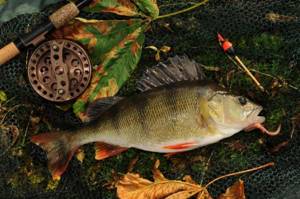
To catch perch, monofilament with a diameter of 0.2 mm should be used as the main fishing line; if desired, you can attach a leash of a smaller diameter to it. The hook is selected depending on the type of bait used. It is better to use medium-sized hooks with a long shank; they are easier for the perch to remove. You can fish from the bottom or half-water.
You should catch perch with a float rod in holes, near bridges and piles, on a rocky bottom, near thickets of grass. If the perch stays in this place, the bite will not take long to arrive. The perch takes the bait powerfully and greedily; hooking, especially on the river, is not required. Fishing for the perch should be done carefully so as not to tear the perch’s lips. The perch rarely leaves the hook, the perch often swallows the bait whole and the process of removing the hook from its mouth can take the angler a lot of time. If one perch is caught, you should wait for the next bites, since the perch stays in schools. If there are no bites for a long time, you should change the place.
The best baits for catching perch on a float rod are: dung and earthworms, bloodworms, maggots. Fishing with live bait gives good results; its size should be no more than 5 cm. The fry is hooked on the back under the fin.
Bottom gear
Bottom tackle provides the best catchability in spring and autumn, when perches stay at a decent distance from the shore, at depth, near the bottom. Bottom tackle for perch can be made either in the form of a hook with an elastic band with several leashes, or on a feeder or spinning rod. Braided line should be used as the main line, and monofilament or fluorocarbon line should be used as leaders. Donkey hooks for perch should be medium-sized with a long shank.
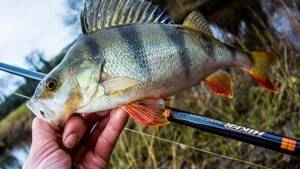
The best baits for catching perch on bottom tackle are considered to be dung or earthworms and live bait. The perch takes powerfully and greedily, immediately after the bite it goes to the side and down, hooking is most often not necessary, the perch is caught on its own. Fishing for the perch should be done carefully so as not to tear the perch’s lips.
Spinning
Spinning rod is ideal for catching perch of all sizes. For perch fishing, the most optimal rod will be a rod with a top weight of up to 12 grams, a length of 2.4 meters, and a medium-fast action. The spinning rod should be equipped with a spinning reel of size 1500-2000, with a front clutch. The reel should be wound with either a monofilament line with a diameter of 0.16-0.18 mm, or a braided cord with a breaking load of 4-6 Lb.

Rotating spoons, silicone baits and wobblers are used as bait for catching perch using a spinning rod.
A spinning spoon is one of the main baits for catching perch using a spinning rod. The spinner is easy to use and easy to catch. For perch fishing, spinners with blade sizes No. 1 and No. 2 are used. Spinners can have different petal shapes; the angle and speed of rotation of the spinner depends on the shape of the petal. An angler should have different types of spoons in his arsenal in order to be able to choose a spoon for specific fishing conditions.
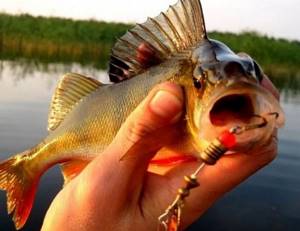
Silicone lures are excellent for catching perch, and in recent years they have even overtaken spinner baits in popularity. The standard size of a silicone bait for catching perch is 4-5 cm; larger perches can be caught using larger baits. Perch is caught using silicone in a variety of colors, so you need to select the color of a twister or vibrotail directly on the pond. The speed of the bait depends on the degree of activity of the perch, which in turn largely depends on the water temperature. When catching perch with silicone baits, both uniform and stepped retrieves are used. Very good results when catching perch are obtained by using spaced-out equipment, primarily a lead and a drop-shot.
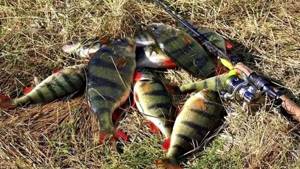
Wobblers have recently been increasingly used by anglers when fishing for perch. One of the most important parameters for a wobbler is the degree of its buoyancy. According to the degree of buoyancy, all wobblers are divided into three large groups: floating (Floating), neutral buoyancy (Suspenders) and sinking (Sinking). Wobblers differ in several classes according to the degree of depth. The depth of the wobbler tells the angler how deep from the surface of the water the wobbler will be when the angler reels in the fishing line. Catching perch with wobblers gives good results when it is at its peak of activity. To catch perch, wobblers are used that have a high-frequency, but not too sweeping action, most often these are minnow wobblers and cranks.
The perch can take the bait at the very surface, in mid-water or at the very bottom; the angler must experiment with baits and the fishing horizon in order to entice the perch to bite. When catching perch, the angler should focus on schools of fry jumping out of the water, which indicate the presence of a hunting school of perch in this place.
Perch on a spinning rod in summer
So, perch lives in almost all freshwater bodies of water, from small rivers to large reservoirs and lakes. You can catch perch in summer in any part of the reservoir, regardless of depth, since the predator can be located either at a depth of more than three meters or in a shallow bay . Most often, especially in the evening and morning summer hours, perch is in the coastal zone, where it actively hunts for fry.
trophy perch on the shallows in summer, since it does not leave deep holes and edges and prefers to be among snags, not far from flooded structures.
On the river, you need to look for perch in calm areas, or in areas close to the reverse current. Perch is especially often found near the shore if there is a fallen tree in the area and the depth under it exceeds two meters. Despite the fact that perch is a diurnal predator, it is best to catch it early in the morning or in the evening . During the day, perch can also be caught, but you will have to work hard to find it. On a large reservoir or lake, you can determine the place where perch feeds by the concentration of seagulls above the water.
For summer perch fishing, stepwise or uniform fishing with pauses of no more than three seconds . In large bodies of water, it is more convenient to catch perch from a boat, since the predator often stays at a great distance from the shore during the day, approaching it only at evening or morning dawn.

How to choose a spinning rod for perch fishing
The spinning rod is equipped based on the weight of artificial baits planned to be used for catching perch. If you plan to fish more often using spinners and wobblers weighing up to 8 grams , then it is recommended to opt for “Light” , while the test load should be in the range of 10-15 grams .
When catching perch with twitching wobblers, a fast and medium spinning rod with an upper test limit of up to 18 grams . If you use small spoons and microjigs , then an Ultralight (read about catching perch with microjigs here).
Regarding the length, the spinning rod must be chosen based on how you plan to catch perch, from the shore or from a boat. In the first case, it is recommended to buy a longer rod, in the second, a shorter one. The ideal length of a spinning rod, with which you can successfully fish both from the shore and from a boat, is 2.1 meters . 2.7 meters long is perfect .
Reel and line
When choosing a reel, it is important to consider the class of the fishing rod on which it will be installed. spool of size 2000 are perfect . As an option, you can consider the ECUSIMA 2000 coil manufactured by RYOBI, which is convenient and reliable. braided cord onto the reel spool .
Lures for catching perch in summer
So, any type of artificial bait is perfect for perch, as long as the size is small . Let us note the options for baits, as well as some models that are most effective:
Oscillating spoons
An excellent choice when fishing for perch in deep water in the summer. trophy perch is most often caught . Among the variety of models offered, we can highlight: the Toby spinner produced by Abu Garsia, Mepps cyclops-0 and cas. When fishing, stepwise and uniform fishing is used.
Spinners
The use of these baits allows you to fish areas in a reservoir of any depth with sparse underwater vegetation. The wiring is done slowly and evenly. The best spinners for summer bass are Blue Fox Super Vibrax and Mepps No. 00, 0, 1 and 2.
Silicone baits
Various types of rubber are used (twisters, foam rubber, worms, vibrating tails). For catching perch, body length options are selected, which are within 1-2 cm . equipping the bait can be done using various options and methods. When fishing, stepwise wiring is mainly used.
Wobblers
poppers are perfect ; in areas with a depth of up to three meters, you can try to catch this predator with wobblers belonging to the “minnow” class. Wiring is performed by jerking or twitching . The greatest demand among anglers is for wobblers “Jaxon Little”, Squad Minnow produced by “Jackall”, Tactic Shad from. In fact, there are a huge variety of perch wobblers on offer today, so there shouldn’t be any problems with purchasing them.
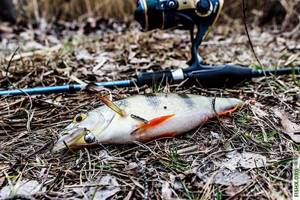
Ways to fish for perch in winter
In winter, perch is caught using spoons, balance beams and jigs.
Fishing for perch in winter using lures
Catching perch with a spoon is perhaps the most interesting way to catch this fish in winter. For lure fishing, you should use a light but durable rod, of medium hardness, 30-40 cm long, with a handle made of cork or other warm material. A light reel should be placed on the rod, onto which a monofilament line with a diameter of 0.14-0.20 mm should be wound. The rod must be equipped with a polymer or metal spring nod. The nod should be elastic and rigid, when lowered to the bottom it should straighten, and when planning the spoon, it should be at an angle of 45 degrees to the rod.
You may be interested in: Sudak
There are two types of winter lures: vertical “stud” type and gliding.
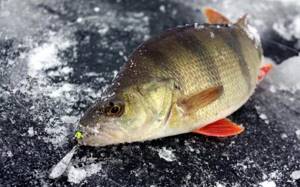
Gliding spoons have a wide, flat shape; when lowered, they deviate significantly from the vertical axis of the dive and at the same time make significant oscillations in amplitude. Gliding lures bring perch to the hole from a great distance. Well suited for catching active perch, for fishing in shallow places in the absence of current.
Vertical spoons or “studs” practically do not deviate from the vertical when immersed. They are narrower and heavier. Vertical spoons come in three and tetrahedral, teardrop-shaped, flat and many other shapes. Well suited for catching both active and passive perch, for fishing in depth or in currents.
In terms of size, lures for perch are: small (up to 2 cm long), medium (3-5 cm long) and large (more than 5 cm long). Smaller spoons catch smaller bass, larger spoons catch larger bass.
The spinner game looks like this: lower the spinner to the bottom, then raise it 3-5 cm, keeping the tip of the rod 15-20 cm from the hole. We shake the spoon a few times, lift it up 40 cm with smooth acceleration, and then sharply lower the rod down to its previous position. The spoon freely sinks to the bottom and makes movements that attract perch. The frequency and intensity of trolling depends on the fishing conditions and the activity of the perch. Between strokes of the rod there should be a pause, the duration of which depends on the angler.
Catching perch in winter using a balance beam
Balancer bait used for catching perch from ice in winter imitates a small fish. The balancer has a plastic or metal tail, thanks to which the balancer moves under the hole in the form of a figure eight or a pendulum.
For fishing with a balancer, you should use a rod 60-80 cm long, equipped with a reel. The most important requirement for a fishing rod is high sensitivity. To catch perch on a balancer, you should use a monofilament line with a diameter of 0.12-0.18 mm. If there is a chance of catching a trophy humpback whale, the diameter of the fishing line can be increased to 0.20 mm.

The balancer is equipped with two single hooks, one of which is located on the head, and the second in the tail of the balancer and a hanging tee. The weight and size of the balancer for perch fishing is selected depending on the fishing conditions. Most often, a balancer for catching perch has a length of 3 to 6 cm and a weight of 4 to 10 grams.
When fishing with a balancer, holes should be drilled at a distance of 5 to 10 meters from each other. After drilling a hole, sprinkle it with snow so as not to frighten the perch with a spot of light. Perch is afraid of light even more than noise.
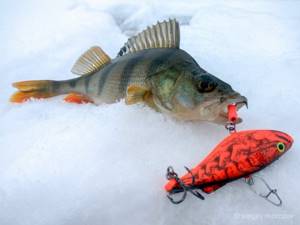
Playing with a balancer looks like this: lower the balancer to the bottom, raise it to a distance of 20-30 cm from the bottom, swing the rod upward 30 cm and lower the tip of the rod, the balancer makes a horizontal movement under water in the form of a figure eight. In order to attract perch, you can lift the mud from the bottom by making several strikes on the bottom with a balancer.
Catching perch with a jig
Catching perch with a jig is a very common winter fishing method loved by many anglers.
A fishing rod for jig fishing should be light and sensitive. The rods should provide a realistic play of the jig, and the caught fish is pulled out by fingering the line with your hands, putting the rod aside, so it should not be particularly strong. The length of the rod should be 20-30 cm; a short rod with a nod allows you to fully feel the excitement of the bite that hits your hand.
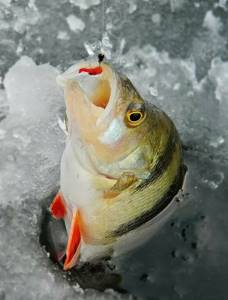
To catch perch with a jig, a rod called a “balalaika” is used; in such a rod, the reel for storing fishing line is also the handle of the fishing rod.
Some fishermen use a rod for jig fishing with a separate reel attached in front of the handle; such a rod allows you to fish not only with a jig, but also in other ways, but does not provide the sensitivity necessary for jig fishing.
The rod is equipped with a nod, which is adjusted to the weight of the jig. With a jig hanging on a fishing line, the nod should go down at an angle of 40-60 degrees to the rod, in this case the play of the jig will be the most realistic.
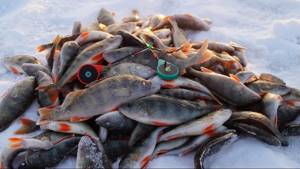
The fishing line for catching perch with a jig should have a diameter of 0.1-0.12 mm. You can use monofilament or fluorocarbon. Some fishermen even use a fishing line with a diameter of 0.06 mm, but such a fishing line will not be able to withstand the weight of a large fish, in addition, the sharp edges of the hole will erase and weaken the fishing line. You need to wind from 15 to 30 meters of fishing line on the reel.
Perch can be caught using jigs all winter. At temperatures below -15 degrees, it stays in the deepest places: holes, whirlpools, dumps. At temperatures around zero, perch stays in shallow waters, closer to the shore. The best time to catch perch with a jig is the first and last ice; during the deep winter it is much less catchable.
When fishing with jigs, holes are drilled in a checkerboard pattern, at a distance of 5-6 meters from each other.
Playing with a jig looks like this: the jig sinks to the bottom with a knock and small vibrations of the nod rise to the surface. The movement of the jig can be slow or fast, uniform or with stops. It is unknown what kind of jig placement will provoke the perch to attack, so the angler must experiment and select the jig's action for specific fishing conditions.
In order to attract perch, you can feed the hole. To do this, they most often use food bloodworms, periodically throwing them in small portions into the hole. You can use dried blood, which is sold in fishing stores, to attract perch. You can combine dry blood with bloodworms, simultaneously throwing them into the hole.
Other ways to catch perch
Also, perch can be caught using a jig, although this method is usually used for fishing in the winter season.
Fishing takes place in the following areas of water bodies:
- Uneven surfaces of the bottom of the reservoir.
- Underwater holes and edges.
- Snags.
For fishing with a jig, you should use the following gear:
- Rod. It should be very light with a fairly receptive nod. This nod should be cone-shaped. Its length must be at least forty millimeters.
- The coil should be small. It is desirable that it be built into the body of the fishing rod.
- The fishing line for perch on a jig should be as thin as possible, but at the same time very high quality. The diameter of the fishing line should be up to 0.7 mm. You should not save on buying fishing line, since the success of the catch largely depends on it.
- Jigs for catching perch come in two varieties: for use with bait and for use without any attachments (reelless). For beginners, it is best to use jigs for bait as they require less fishing skill. To catch perch, you should purchase small jigs, five millimeters in diameter and weighing up to 0.4 grams. It is better to buy such devices in the form of a drop and a larva. They both look great.
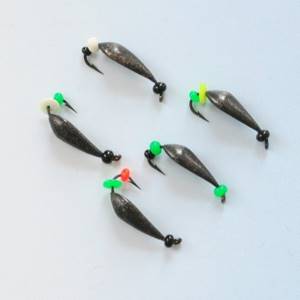
Fishing with a jig has the following features:
- You can fish with this tackle both from a boat and from the shore. If the fishing takes place from a boat, then you need to plunge the jig to the bottom, and then slowly pull it towards you. In addition, you can fish with a stationary jig, which will always be at the very bottom of the reservoir.
- If the fishing takes place in a reservoir where there is a lot of algae and other vegetation, then the fisherman must be extremely careful to prevent the jig from getting caught. In such fishing conditions, the jig should be lowered no more than twenty-five centimeters in depth. Then you should lift it up and lower it again, as if playing with it. This will attract the perch and make it swim closer. If after this there is no bite, then you should change the fishing location.
- To fish from the coastal zone, you need to choose a large bank where you can walk. After casting the jig, it should be carried along the shore.
- You should know that if you quickly retrieve the jig, it will attract small perch. If you make a slow retrieve (two seconds per meter) and raise the fishing rod to attract larger perches.
- To fish with a jig in the summer season, you should definitely select a fishing rod with a very sensitive nod. You can also use two jigs at once, this will improve the chances of catching.
- Worms or large bloodworms can be used as bait. In addition, artificial baits that are made in the form of flies are also suitable.
"Balda"
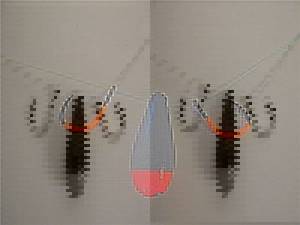
To use it, you need to prepare the following gear:
- Hooks No. 6.
- Drop-shaped weights weighing up to fifty grams.
- Fishing rod for winter fishing.
- Multi-colored cambrics.
- Line with a diameter of 0.3 mm.
The fishing technique with this gear has the following features:
- First you need to choose the right place for fishing. It is best to fish with the “bulda” tackle from a boat.
- Then the bait should be slowly lowered to the bottom of the reservoir so that it hits it and raises a cloudy cloud. Next, you should lower the hooks that follow it.
- The use of cambrics, beads and flies on hooks helps make the movements of the tackle smoother.
- The fish are attracted by the turbidity that arises from the gear, so for fishing with a “bald” it is better to look for places for catching perch with a muddy bottom.
- You will immediately feel the bite by the characteristic twitching of the rod tip. There is no need to rush and immediately pull out the catch. Wait until the perch is completely hooked and only then hook.
Plumb fishing with a long rod, fishing with a short rod

Plumb fishing with a long rod is usually practiced in deep lakes and ponds. This method is used in hot weather, when the perch is hiding under the bottom of the boat and it is difficult to get them with a float rod, but it is much easier with a rod without a float. Fishing can be done from bridges, but it works best from a boat.
For vertical fishing with a long fishing rod, the following gear should be used:
- A fishing rod with a length of six meters. The rod tip should be very flexible and susceptible to bites.
- Hooks No. 3.
- Weights in the form of small pellets.
- Long fishing line with a diameter of 0.9 mm.
Plumb fishing occurs as follows:
- Throw the tackle to a depth of at least two and a half meters so that the line is taut and the bait rises from the bottom by twenty centimeters.
- When there is a bite, you can easily notice it by the tip of the fishing rod, which will twitch a little.
- If a bite occurs, then you need to immediately make a quick but gentle hook.
Plumb fishing with a short rod usually occurs both from the shore and from a boat. This method is best for catching perch in summer and autumn.
To fish vertically with a short fishing rod, you should prepare the following gear:
- A rigid rod with a length of three meters and forty grams of dough.
- The reel is inertialess.
- Monoline with a diameter of 0.22 mm.
- Spoons or wobblers with good action.
The vertical fishing process follows this principle:
- Throw the tackle into the water to a depth of no more than two meters.
- Wait until the bait reaches the middle of the water level, then make a quick upward swing with the fishing rod so that the spoon or wobbler rises about another twenty centimeters. After this, you should release the fishing rod so that the bait returns to its original position.
- This process should be repeated several times, making short stops.
- When a perch bites, the rod tip will twitch and this means that you should make an immediate hook before the fish leaves.
- As usual, you should reel in the catch very carefully so as not to break the perch’s lip.
